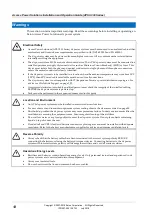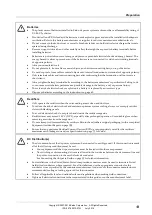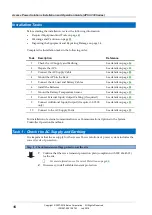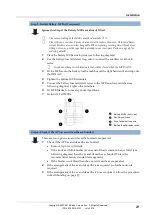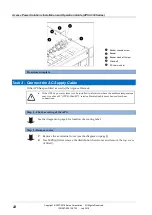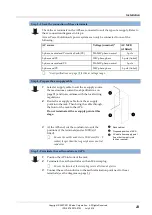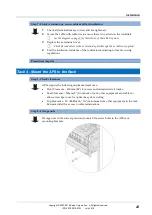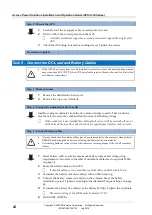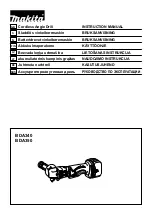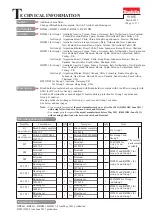
Preparation
Copyright © 2007-2018 Eaton Corporation. All Rights Reserved.
IPN 997-00012-07A1 July 2018
13
Batteries
•
The plastic cases of batteries installed in Eaton dc power system racks must have a flammability rating of
UL 94-V2 or better.
•
Flooded cell and VRLA lead acid batteries can emit explosive gases and must be installed with adequate
ventilation. Refer to the battery manufacturer or supplier for advice on minimum ventilation levels.
•
Do not wear a synthetic dust-coat or overalls. Synthetic fabrics can hold static electric charges that create
sparks during discharge.
•
Remove rings, wristwatch and other metal jewellery that might be exposed to battery terminals, before
installing batteries.
•
Batteries are powerful sources of energy and present a potential electrical shock and energy hazard. The
energy hazard is always present, even if the batteries are not connected. Avoid short circuiting terminals
of opposite polarity.
•
Always use insulated tools.
•
Do not place tools, loose cables or metal objects (such as interconnecting bars) on top of batteries.
•
Do not drop tools, loose cables or metal objects onto intercell connections or terminals of opposite polarity.
•
Only terminate cables and interconnecting bars after confirming that the termination will not create a
short circuit.
•
Always tighten battery terminal bolts according to the battery manufacturer’s specification. Failing to do
so can cause erratic battery performance, possible damage to the battery, and/or personal injury.
•
There is a risk of electric shock or explosion if a battery is replaced by an incorrect type.
•
Dispose of batteries according to the instructions on page
Rectifiers
•
Only operate the rectifiers when the surrounding area is clean and dust free.
•
To reduce the risk of electric shock and maintain optimum system cooling, always cover empty rectifier
slots with blanking panels.
•
To avoid electrical shock, do not place hands inside the rectifier magazine.
•
Rectifier cases may exceed 100ºC (212ºF), especially after prolonged operation. Use suitable gloves when
removing a rectifier from the magazine.
•
Do not attempt to disassemble faulty rectifiers. Return them (in their original packaging) with a completed
Equipment Incident Report on page
•
Ensure that any upstream Residual Current Devices (RCDs) are appropriately rated for the rectifiers'
maximum earth leakage current (see Specifications on page
for value).
DC Distribution(s)
•
The dc common bus of the dc power system can be connected to earth (ground). If this connection is made
all of the following conditions must be met:
•
Your equipment and the dc power system must be located within the same premises.
•
No switching or disconnecting devices are allowed in the conductor between the dc common line and
the point of connection to the earth electrode conductor.
See Connecting the Output to Earth on page
for further information.
•
For installations in the United States, Listed compression connectors must be used to terminate Listed
field-wired conductors where required. For all installations, use the appropriate connector for the
conductor size as specified by the connector manufacturer. And use only the connector manufacturer's
recommended tooling or tooling approved for that connector.
•
Follow all applicable local and national rules and regulations when making field connections.
•
Tighten all electrical connections to the torques stated in this guide or on the manufacturer's label.














